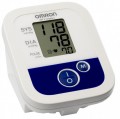Power source
Type of power source of the blood pressure monitor. Power is required only for automatic and semi-automatic models (see "Type") — mechanical ones work solely due to the muscular strength of the user.
—
Batteries. The blood pressure monitor is powered by replaceable batteries that have a standard size — for example, AA. Such devices are autonomous, because they do not require a mains connection, and batteries are purchased without problems and are easy to change, unlike
built-in batteries (see below). On the other hand, batteries are usually not included in the package, and you have to buy them regularly, which is associated with corresponding expenses. An alternative is to buy the elements in the form of rechargeable batteries; they are quite expensive, however, having paid once for batteries and a charger, you no longer have to spend money on energy sources. Anyway, all blood pressure monitors with measurement on the wrist (see "Measuring place"), as well as some models of "shoulder" models, are powered by batteries.
— Batteries/mains. These blood pressure monitors offer dual power options, allowing them to operate on both replaceable batteries and a 230 V
network. This versatility enables battery usage in remote locations and the convenience of plugging into the network in more conventional settings to conserve battery life. However, the use of the net
...work requires a power source and adds bulk to the complete set. As a result, this type of power supply is exclusive to blood pressure monitors with measurements on the upper arm.
— Battery. These blood pressure monitors are powered by a proprietary, non-standard battery that is often non-removable. Similar to standard batteries, these power sources provide autonomy, allowing the device to function without nearby outlets. However, recharging the exhausted battery requires an electric source, typically an outlet, and the process is time-consuming. As a result, this power supply type is not widely adopted in blood pressure monitors and is primarily found in compact models where the use of standard batteries is technically impractical.Batteries
The type of batteries used in blood pressure monitors.
— AA. One of the most common types of batteries today. Voltage — 1.5 V. One of the main advantages of this type of power supply is availability:
AA batteries are sold almost everywhere where any batteries are sold at all.
— AAA. A kind of reduced analogue of AA batteries (see above) with the same operating voltage of 1.5 V.
AAA batteries are also very common, and the dimensions allow them to be used in more compact devices.
Recording readings
The number of results that can be simultaneously stored in the blood pressure monitor's memory. The ability
to store several results in memory can be useful, for example, to compare pressure readings in the morning, afternoon and evening — these results do not have to be manually recorded or memorized.
Functions
—
Pulse measurement. The ability to use a blood pressure monitor to measure heart rate (pulse). This frequency, along with blood pressure, is one of the most important indicators of the state of the cardiovascular system.
—
Determination of arrhythmia. Blood pressure monitors with this feature are able to track irregularities in the heartbeat (arrhythmia) — one of the important signals of health problems — and warn the user about it.
—
Medium pressure calculation. This function allows you to automatically calculate the average pressure based on several consecutive measurements.
—
Signal about measurement errors. Blood pressure monitors with this function are able to display error signals that can affect the accuracy of measurements — such as incorrect cuff application, air leakage from it, movement during measurement, device electronics failure, etc.
—
Auto switch-off. Most semi-automatic and automatic models of blood pressure monitors are able to automatically turn off after a few minutes of inactivity. This saves battery power.
—
Synchronization with PC. In this case, a wired connection is implied, not
Bluetooth. Synchronization of the blood pressure monitor with a PC allows you to track
...all the measurement results in one table (in some models — even with the date and time), save the results to the PC, freeing up the device's memory, select measurements for calculating the average pressure, etc.
— Bluetooth. The presence of wireless data transfer technology allows you to use the features described in the paragraph "Synchronization with a PC" by connecting to a smartphone and using a special application. This method is more mobile, easier and faster.
— Voicing the measurements. Such blood pressure monitors are able not only to display the measurement results on the screen, but also to voice them, which can be very useful for elderly people with poor eyesight.
— Date and time indication. Having the ability to display the current date and time is useful for recording blood pressure measurements and tracking them over time. Blood pressure monitors equipped with a clock and calendar feature can automatically store measured pressure results in memory, associating them with specific date and time stamps when there is a recording mode.
— WHO colour scale. The World Health Organization has established standards defining normal, low, or elevated blood pressure values. These standards incorporate a color scale that, after each measurement, aids in assessing the pressure status and determining appropriate actions. It's important to note that individual variations exist, and what constitutes normal pressure differs for each person. Therefore, these standards are generally advisory, providing guidance rather than prescribing specific actions.
